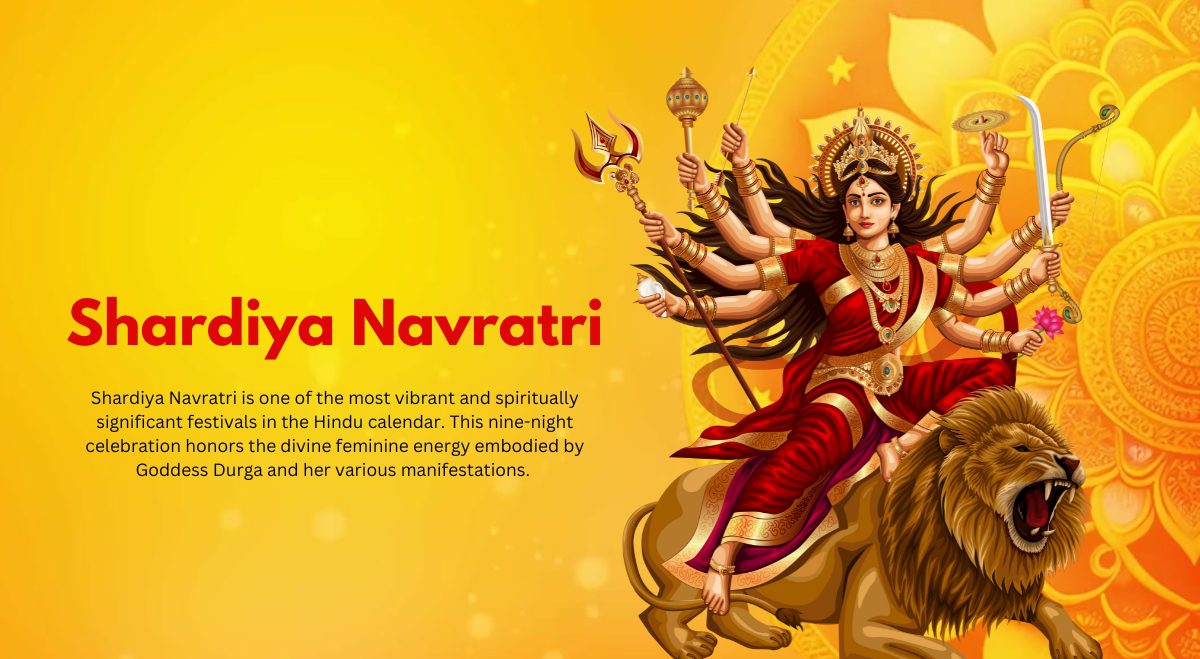Shardiya Navratri is one of the most vibrant and spiritually significant festivals in the Hindu calendar. This nine-night celebration honors the divine feminine energy embodied by Goddess Durga and her various manifestations. As we look ahead to Shardiya Navratri 2025, let’s explore the rich traditions, profound meaning, and key dates for this auspicious occasion.
Table of Contents
Shardiya Navratri, also known as Sharad Navratri or simply Navratri, is a major Hindu festival celebrated in the autumn season. The term “Navratri” literally means “nine nights” in Sanskrit, during which devotees worship the nine forms of Goddess Durga. While there are four Navratri throughout the year, Shardiya Navratri is considered the most important and is celebrated with great fervour across India out of five types of Navratri.
The mythology behind Shardiya Navratri centers around the epic battle between Goddess Durga and the demon king Mahishasura. According to Hindu scriptures, Mahishasura had received a boon that made him invincible against any male god or mortal. Drunk on power, he began terrorizing both heaven and earth.
To defeat this seemingly unbeatable foe, the gods combined their powers to create Goddess Durga – the ultimate embodiment of divine feminine energy. For nine days and nights, Durga battled Mahishasura, finally vanquishing him on the tenth day. This victory of good over evil is celebrated as Vijayadashami or Dussehra.
Shardiya Navratri holds deep spiritual and cultural significance for Hindus:
- It symbolizes the triumph of good over evil and light over darkness
- The nine nights represent the nine forms of Goddess Durga, each embodying different virtues and powers
- It’s a time for spiritual renewal, self-reflection, and devotion
- The festival marks the transition from summer to autumn, celebrating nature’s cycles
- It brings communities together through shared rituals, feasts, and cultural performances
Mark your calendars for these important dates in 2025:
- Navratri begins: Monday, September 22, 2025
- Navratri ends: Tuesday, September 30, 2025
- Dussehra (Vijayadashami): Wednesday, October 1, 2025
Ashtami, the eighth day of Navratri, holds special significance. In 2025, Navratri Ashtami falls on:
- Monday, September 29, 2025
Ashtami is considered particularly auspicious as it’s believed to be the day when Goddess Durga’s power reaches its peak. Many devotees observe strict fasts on this day and perform special pujas.
Navratri celebrations vary across regions, but some common traditions include:
- Fasting: Many devotees observe partial or full fasts during the nine days
- Durga Puja: Elaborate worship rituals are performed, especially in eastern India
- Garba and Dandiya: Traditional dance forms popular in Gujarat and beyond
- Kanya Pujan: Young girls are worshipped as embodiments of the goddess
- Recitation of scriptures: Many households read the Devi Mahatmya or Durga Saptashati
- Colorful decorations: Homes and public spaces are adorned with flowers and lights
- Special foods: Fasting-friendly dishes and sweets are prepared and shared
Conclusion
Shardiya Navratri is more than just a festival; it’s a celebration of divine feminine power, a time for spiritual growth, and an opportunity to come together as a community. As we look forward to Navratri 2025, may we all embrace the spirit of renewal and positive transformation that this auspicious time brings.
Whether you’re a devout follower or simply curious about Hindu traditions, Shardiya Navratri offers something for everyone. From the vibrant cultural displays to the deep spiritual practices, it’s a festival that truly captures the essence of India’s rich heritage.
What are your favorite Navratri traditions or memories? Share in the comments below – I’d love to hear how you celebrate this special time!

